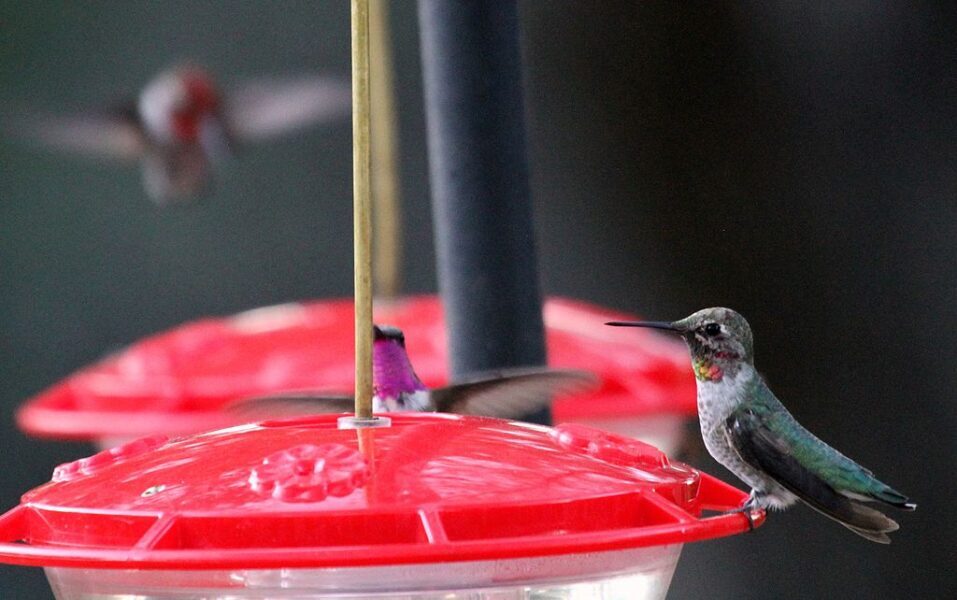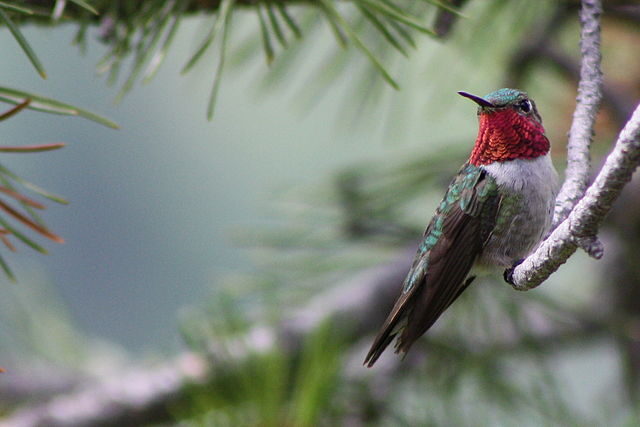Hummingbirds are tiny jeweled birds that are known for their excellent hovering skills and speed. Arizona is a beautiful place for hummingbirds. Most hummingbirds are migratory and stop by to breed or pass through Arizona to the border states. Also, some hummingbirds live in the south and occasionally pop up to visit Arizona, while a few live all year around.
This article will be looking at the 12 most popular hummingbirds in Arizona.
1. Blue-throated Mountain-gem
 alt=”humming birds in arizona” class=”wp-image-851″ width=”665″ height=”1043″/> Lampornis_clemenciae humming birds in arizona
alt=”humming birds in arizona” class=”wp-image-851″ width=”665″ height=”1043″/> Lampornis_clemenciae humming birds in arizona
Botanical name : Lampornis clemenciae
Blue-throated Mountain gems are the largest hummingbirds that nest in the United States, but they are rarely spotted in Arizona.
- Length: 4.3-4.7 in (11-12 cm)
- Weight: 0.3-0.3 oz (8.1-8.6 g)
They primarily reside in Mexico. You can easily spot them on mountainous woodlands along streams. They are also seen in areas with lots of flowers, and they visit your backyard for feeders.
The nesting of Blue-throated Mountain gems is typically bigger, and they measure 2 inches wide and 3 – 10 inches high.
2. Lucifer Hummingbird
 Lucifer_hummingbird_
Lucifer_hummingbird_
Botanical name: Calothorax lucifer
Lucifer hummingbirds can easily be spotted around Madera Canyon, Millers Peak, and Cave creek.
- Length: 3.9 in (10cm)
- Weight: 0.1-0.1 oz (3-4 g)
You can easily find the Lucifer hummingbird in desert habitats and dry canyons. They feed primarily on flowering agaves, ocotillo, and century plants.
Their Nests are usually made of Cacti or succulents and they usually have one or two broods a year.
3. Broad-billed Hummingbirds
 Broad-billed Hummingbird
Broad-billed Hummingbird
Botanical name: Cynanthus latirostris
Broad-billed Hummingbirds are commonly found around Phoenix and Tucson in Arizona during the summer between March and October. However, you can see them all year round but not in many quantities.
- Length: 3.1 – 3.9 in (8-10 cm)
- Weight: 0.1-0.1 oz (3-4 g)
You can find Broad-billed Hummingbirds all year in central Mexico and the Pacific Coast of Mexico. Some of the species are migratory, and they travel north into mountain canyons in southern Arizona and New Mexico to breed and remain at New Mexico all year round. They build their nests quite low to the ground, usually about 3 feet near streams.
You can easily located Broad-billed Hummingbirds in canyon streams and mountain meadows where they found foraging for food.
Also, they feed on backyard feeders, which makes them a regular visitorto your backyard.
4. Anna’s Hummingbird
 Anna’s Hummingbird
Anna’s Hummingbird
Botanical name: Calypte anna
Anna’s Hummingbirds are popular tiny birds in Arizona that accounts for about 25% of the hummingbirds’ population. You can easily see them during spring and fall in Arizona winter.
- Length: 3.9 in (10 cm)
- Weight: 0.1-0.2 oz (3-6 g)
- Wingspan: 4.7 in (12 cm)
Anna’s Hummingbirds are non-migratory, and they are the most common Hummingbird along the Pacific Coast.
Anna’s Hummingbirds often have two to three broods every year, and they build their nest on high trees, especially trees around 6 – 20 ft.
Often, Anna’s hummingbirds live in backyards and parks. You can also find them in Savannah and the scrub. They feed primarily on nectar feeders.
5. Costa’s Hummingbird
 Costa’s Hummingbird
Costa’s Hummingbird
Botanical name: Calypte costae
Costa’s Hummingbirds are commonly seen in southern Arizona around Tucson, Phoenix, and Kofa National Wildlife Refuge. You can also spot them when they come to breed during the summer, except in the northeast part of the state.
- Length: 3.5 in ( 7.6 – 8.8 cm)
- Weight: 0.1-0.1 oz (2-3 g)
Costa’s Hummingbirds are majorly desert hummingbirds with vivid iridescent purple throat patches that flare out and a purple crown.
Also, they are regarded residents of Baja California, southern California and southwestern Arizona. They are migratory birds that travel between the Pacific Coast of Mexico in winter and up into Arizona, and even to the southern edges of Nevada and Utah and California for breeding.
Costa’s Hummingbirds, habitat are mostly Desert scrub, chaparral, and deciduous forest. They make their nest relatively low to the ground, at ground seven feet above the grounds. Also, they nest on shrubs and sometimes have to broods a year.
6. Black-chinned Hummingbird
 Black-chinned Hummingbird
Black-chinned Hummingbird
Botanical name: Archilochus alexandri
Black-chinned Hummingbirds are migratory birds that arrive in Arizona to breed around March to Mid-November; they can start migration as easily as February at certain times.
- Length: 3.5 in (9 cm)
- Weight: 0.1-0.2 oz (2.3-4.9 g)
- Wingspan: 4.3 in (11 cm)
Black-chinned Hummingbirds breed mostly on the inland in western states before migrating to the western Mexico and the Gulf Coast in the winter.
Black-chinned Hummingbirds feed on nectar, small insects, and spiders.
Black-chinned Hummingbirds make their nests from plants and use spider silk to glue them together. Every year, they only lay two eggs.
You can easily see Black-chinned Hummingbirds on top of dead trees on tiny bare branches. You can also find them along canyons, shady oaks, rivers and by shady oaks in the Gulf Coast.
7. Broad-tailed Hummingbird
 Broad-tailed Hummingbird
Broad-tailed Hummingbird
Botanical name: Selasphorus platycercus
Broad-tailed hummingbirds are commonly seen in summer around March to October in Arizona, where they breed in mountain meadows. Often times, Broad-tailed Hummingbirds live in higher elevations.
- Length: 3.1-3.5 in (8-9 cm)
- Weight: 0.1-0.2 oz (2.8-4.5 g)
There is one interesting thing about these hummingbirds because it lives in high elevation; during the cold, the Broad-tailed Hummingbird can slow down their heart rate and drop their body temperature to enter a state of torpor.
Also, Broad-tailed Hummingbirds breed in mountainous west on open woodlands and high meadows between 5,000 – 10,000 feet elevation, usually between late May and August, before traveling down to southern Mexico to spend the winter.
Broad-tailed Hummingbirds feed on red columbine, larkspur, sage, scarlet gilia and visit the nectar feeders. They also feed on both adult and small young insects.
Broad-tailed Hummingbird build their nests on aspen branches made of spider webs and gossamer. Due to the fact they live in high elevations, their nesting is built under overhanging branches, which gives added insulation to their eggs on cold nights.
8. Rivoli’s Hummingbird
 Rivoli’s Hummingbird
Rivoli’s Hummingbird
Botanical name: Eugenes fulgens
Rivoli’s Hummingbirds are rarely seen in Arizona, however they can be spotted at the southeast of the state in Mt Lemmon, Mt Graham, Oak Creek Canyon, Madera Canyon, and canyons.
Also, Rivoli’s Hummingbirds are large hummingbirds with more conspicuous coloring than most hummingbirds.
- Length: 4.3-5.5 in (11-14 cm)
- Weight: 0.3-0.3 oz (7-8 g)
Additionally, Rivoli’s Hummingbirds are residents of Central America and Mexico, with some migrating north into southern Arizona, New Mexico, and southwestern Texas.
You can easily find Rivoli’s Hummingbirds on pine-oak forests in mountainous regions. They also visit the backyard for feeders.
Their nests are mostly built up high.
9. Violet-crowned Hummingbird
 Violet-crowned Hummingbird
Violet-crowned Hummingbird
Botanical name: Amazilia violiceps
Violet-crowned Hummingbirds of Arizona are medium-sized birds that are commonly found around Huachuca Canyon, Miller Peak, and the Paton Center.
- Length: 4 in (10 cm)
- Weight: 0.18 oz (5 g)
Violet-crowned Hummingbirds are migratory birds thattravel from southwestern New Mexico, mountains in southeastern Arizona, down to southwestern Mexico, and arrive in the United States in February or March. After which it travels to Arizona during April and September to breed.
During winter, they visit your backyard for backyard feeders.
Violet-crowned Hummingbirds live majorly in tropical semiarid scrub and deciduous forests.
Additionally, their nesting is oftentimes done in sycamore or oak trees.
10. Rufous Hummingbird
 Rufous Hummingbird
Rufous Hummingbird
Botanical name: Selasphorus rufus
Rufous Hummingbirds are popularly seen during fall migration in Arizona but sometimes spotted during spring migration. However, you can spot some of it during winter in the state’s southeast.
- Length: 2.8-3.5 in (7-9 cm)
- Weight: 0.1-0.2 oz (2-5 g)
- Wingspan: 4.3 in (11 cm)
Rufous Hummingbirds are regarded as the longest migrating birds of their size. They travel a distance of 4000 miles each way.
They spend their winter in Mexico and the Gulf Coast before migrating to northwest Alaska to breed. They also travel north along the Pacific Coast and the Rocky Mountains during late summer and fall.
Rufous Hummingbirds’ feeding primarily feeds on nectar from insects such as gnats, midges, flies, and colorful tubular flowers. Their nesting is mad high on trees and is made of soft plant down and spider webs which hold it glued together.
Rufous Hummingbirds are very aggressive birds that chase off any other hummingbirds that may appear, even larger hummingbirds along their path during migration.
You can spot them in mountain meadows and woods, and forests during winter.
11. Calliope Hummingbird
 Calliope Hummingbird
Calliope Hummingbird
Botanical name: Selasphorus calliope
Calliope Hummingbirds are the smallest bird in the United States, usually the shape of a tiny ping ball. They are often seen in Arizona during fall migration between mid-July and mid-September. You can spot them in small quantities during the spring migration around April and mid-May, mainly in the state’s southwest.
- Length: 3.1-3.5 in (8-9 cm)
- Weight: 0.1-0.1 oz (2.3-3.4 g)
- Wingspan: 4.1-4.3 in (10.5-11 cm)
Despite their small size, they can fly more than 5000 miles yearly from Mexico to Canada and back.
That’s one fantastic thing about the Calliope hummingbird, and they are great defenders of their territory. They have the capacity to punch above their weight to defending their territory, and even go as far as chasing Red-tailed Hawks.
They usually build their nests on evergreen trees. They can use their nests or create a new one on top of them.
12. Allen’s Hummingbird
 Allen’s Hummingbird
Allen’s Hummingbird
Botanical name: Selasphorus sasin
Allen’s Hummingbirds is a rare species of Humming bird that is only seen during the second half of February and during fall migration between July and November only in the southeast of the state.
- Length: 3.5 in (9 cm)
- Weight: 0.1-0.1 oz (2-4 g)
- Wingspan: 4.3 in (11 cm)
Allen’s Hummingbirds are migratory birds that spend their winter in Mexico and migrate very early the following year to the Pacific Coast in California and Oregon. While some resident in central Mexico and around Los Angeles
The Allen hummingbird builds nests close to shady streams and has up to 3 broods a year.
FAQs on Hummingbirds in Arizona
What is the season for humming birds in Arizona?
April through October are usually the months where you can quickly see hummingbirds, especially in southeastern Arizona.
Do hummingbirds stay in Arizona all year?
A few hummingbirds stay all year in the warmer parts of the state. Still, the majority of the hummingbird species arrive in southeastern Arizona in April or May and leave by early October.
What is the largest hummingbird in Arizona?
The blue-throated Humming bird is the largest in Arizona. However, it is the least seen Hummingbird in Arizona, second to Lucifer hummingbird.
Watch More Humming Birds Of Arizona Video
Conclusion
I hope you loved and found this article exciting. For further reading on this exciting topic, do check out this, “8 Most Beautiful owls in Connecticut-breathtaking-free-printable-pics.“
